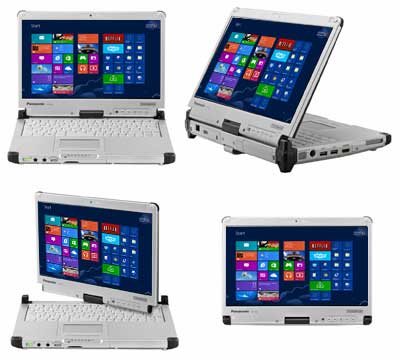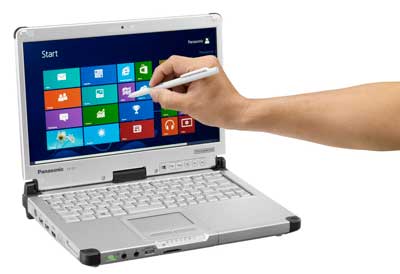On October 26, 2012, Panasonic introduced the Toughbook C2, the company's first Toughbook model specifically optimized for Windows 8. The C2 is a convertible Tablet PC, which means it can be used both as a regular notebook and also as a tablet by rotating the display and folding it down flat on top of the keyboard.
The 12.5-inch wide-format display splits the difference between iPad-class 10-inch media tablets and the 15-16-inch displays of standard size notebooks. The whole thing weighs about four pounds; a lot for a tablet, but not very much for a multi-functional notebook. And, of course, the Toughbook C2 is optimized for Windows 8, with the most important optimization being 5-point capacitive multi-touch and an electronic pen.
Below you can see the Toughbook C2 and the various ways that it can be used in:

Now first, is this a real Toughbook or not? It is and it isn't. Panasonic generally calls this class of mildly (but very intelligently) modified notebooks "business-rugged." But the new C2 is termed "Semi-rugged," with a look that's somewhere between the really rugged Toughbooks and the business class models. How did that come to be?
Those familiar with Panasonic's product lineup know that in addition to the various rugged tablets and notebooks sold in the US and elsewhere under the "Toughbook" name, Panasonic also has a lineup of lightweight notebook computers marketed under the "Let's Note" name in Japan. Part of that lineup is available in the US under the Toughbook name, such as the F9, S10 and the recently introduced SX2. The new Toughbook C2 visually has genes from both sides of its parentage, and that makes it rather unique.
Is the new Toughbook C2 a direct replacement for the Toughbook C1 that is also a convertible notebook/tablet of pretty much the same size? Again, yes and no. The C1 is "business-rugged" whereas the C2 is "semi-rugged" although the actual ruggedness specs are roughly the same. A more relevant differentiation is the readiness for Windows 8. The C1 also has a wide-screen, but it's 16:10 1280 x 800 pixels while Microsoft decreed that for Windows 8 Pro, 16:9 1366 x 768 pixel was the starting point, and if you wanted to use touch, it had to be multi-touch (which the C1 actually also has). The Toughbook C2 fills both of those requirements. And Panasonic also included enough sensors to support all those new functions possible in Windows 8: ambient light, magnetic, acceleration, and gyro. But even that is not all: since even in Windows 8 most "classic" software is easier to use with a mouse or a precise pen, Panasonic added an active pen. Much appreciated.

Panasonic also made sure to equip this new Toughbook with enough advanced technology to make it a pleasure to use. There is, for example, a state-of-the-art Intel 3rd generation Core i5 processor (the i5-3427U) running at 1.8GHz and up to 3.0 GHz with Turbo Boost. 3rd gen Core processors provide much better graphics performance and are far more power-efficient than earlier generations, so the C2 should be plenty quick.
Despite the frugal nature of the processor, Panasonic didn't skimp with battery power. The standard battery packs 73 watt-hours, good for about 11 hours of continuous use. If that's not enough, there's a long-life battery with 100 watt-hours, good for 15 hours. If weight is the primary concern, a lightweight battery with 36.5 watt-hours should still get about 5.5 hours. And Panasonic even added a small bridge battery.
As far as ruggedness goes, "semi-rugged," in our opinion, is a bit of an overstatement here. While there are no official definitions of what constitutes semi-rugged, a 2.5 foot drop is barely higher than a desk, and if you were to apply the full MIL-STD testing procedures, the limit would be a mere foot. No sealing either, other than a spill-proof keyboard. And no other listed ruggedness specs. That is rather marginal for a semi-rugged Toughbook, and we suspect the C2 can handle a good bit more than that. Perhaps Panasonic used the usually hyper-conservative environmental specs from the Japanese market manuals.
For connectivity, the Toughbook C2 also benefits from the Intel third generation Core platform as that includes native USB 3.0 support, which means up to ten times the data transfer speed. There is also a new and quicker Intel Centrino WiFi module, and Bluetooth is version 4.0. Optionally available: 3G Gobi 3000 or 4G LTE mobile broadband. And with all of this new technology, Panasonic still offers optional legacy support for those who need it (serial and modem).
On the memory side, users get 4 to 8GB of speedy DDR3L RAM, with the "L" standing for the power-conserving kind introduced for use with the 3rd gen Core chips. Standard mass storage is a shock-mounted "flex-connect" 500GB hard disk. 128 or 256GB solid state disks are available for those who want the extra speed. Unfortunately no optical drive. I know, they are going away, but they are still useful. Especially with all those metered and capped wireless plans the telcos are forcing on people.
Cost may be an issue. The Toughbook C2 starts at US$2,949, and that's quite a lot in this day and age of $399 tablets and $999 fully equipped Ultrabooks. But these are machines made for business and vertical markets such as healthcare or field sales and service where total cost of ownership matters, and where Panasonic's 3-year warranty, lifetime tech support, and astronomically low failure rates become an important part of the equation.
If all this sounds that we're a bit lukewarm on the C2, that's really not the case. If the price is not a dealbreaker, customers get a lot with the Toughbook C2. It's a modern machine with the latest technology, a very bright (500 nits) wide-format display protected with Corning Gorilla Glass, both capacitive multi-touch and an active pen, plenty of speed and performance, quiet operation without a fan, excellent connectivity, superior battery life and Panasonic's excellent design and workmanship.



